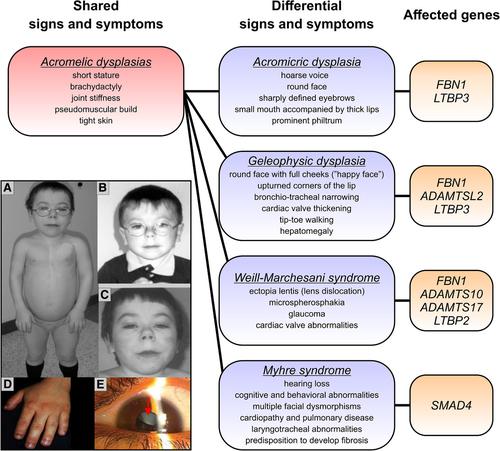当前位置:
X-MOL 学术
›
Ann. N. Y. Acad. Sci.
›
论文详情
Our official English website, www.x-mol.net, welcomes your feedback! (Note: you will need to create a separate account there.)
Acromelic dysplasias: how rare musculoskeletal disorders reveal biological functions of extracellular matrix proteins
Annals of the New York Academy of Sciences ( IF 5.2 ) Pub Date : 2020-09-02 , DOI: 10.1111/nyas.14465 Sarah Stanley 1 , Zerina Balic 1 , Dirk Hubmacher 1
Annals of the New York Academy of Sciences ( IF 5.2 ) Pub Date : 2020-09-02 , DOI: 10.1111/nyas.14465 Sarah Stanley 1 , Zerina Balic 1 , Dirk Hubmacher 1
Affiliation

|
Acromelic dysplasias are a group of rare musculoskeletal disorders that collectively present with short stature, pseudomuscular build, stiff joints, and tight skin. Acromelic dysplasias are caused by mutations in genes (FBN1, ADAMTSL2, ADAMTS10, ADAMTS17, LTBP2, and LTBP3) that encode secreted extracellular matrix proteins, and in SMAD4, an intracellular coregulator of transforming growth factor-β (TGF-β) signaling. The shared musculoskeletal presentations in acromelic dysplasias suggest that these proteins cooperate in a biological pathway, but also fulfill distinct roles in specific tissues that are affected in individual disorders of the acromelic dysplasia group. In addition, most of the affected proteins directly interact with fibrillin microfibrils in the extracellular matrix and have been linked to the regulation of TGF-β signaling. Together with recently developed knockout mouse models targeting the affected genes, novel insights into molecular mechanisms of how these proteins regulate musculoskeletal development and homeostasis have emerged. Here, we summarize the current knowledge highlighting pathogenic mechanisms of the different disorders that compose acromelic dysplasias and provide an overview of the emerging biological roles of the individual proteins that are compromised. Finally, we develop a conceptual model of how these proteins may interact and form an "acromelic dysplasia complex" on fibrillin microfibrils in connective tissues of the musculoskeletal system.
更新日期:2020-09-02



























 京公网安备 11010802027423号
京公网安备 11010802027423号